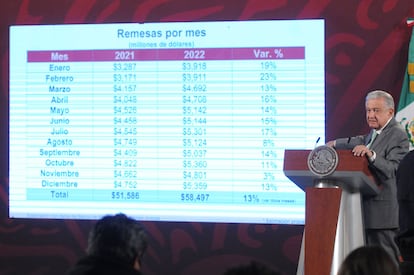US remittances to Mexico will continue to grow this year, but at a slower pace
Various Republican proposals, including one from vice-presidential candidate J.D. Vance, look to impose a tax on money transfers to the neighboring country


The United States is the largest provider of remittances to Mexico, but growth that has been registered in recent years will not continue at the same rates. In 2023, the money sent by migrants to their families grew by 8% over the previous year, but this year, that rise is expected to be just 3%. Despite this, with an estimated total of $65 billion in 2024, remittances sent from the United States will continue to be a fundamental source of income for many families in the neighboring country.
A study by Inter-American Dialogue co-authored by Manuel Orozco and Patrick Springer highlights the fact that one of the reasons behind the smaller amount of sent capital is inflation. “Even so, the volume of emissions will continue and will play a central role in U.S.-Mexico relations,” it states.
Immigration is playing a central role in the political debate leading up to fall elections in the United States. The Republican party has presented various initiatives, many of them unsuccessful, that involve taxing remittances. Donald Trump’s vice-presidential running mate J.D. Vance himself proposed legislation last December that would impose a tax on money sent to other countries.
The proposal from Vance
Vance’s Withholding Illegal Revenue Entering Drug Markets (WIRED) Act looks to impose a 10% tax on remittances. According to the senator from Ohio, a good part of the money that Mexicans send to their home country does not go to alleviate precarious familial situations, but rather, to fatten the pockets of criminal organizations. “This legislation is a common sense solution to disincentivize illegal immigration and reduce the cartels’ financial power,” Vance said in a statement. The money collected through the tax would go to a fund to strengthen the U.S.-Mexico border against immigration, according to the proposal, which has been submitted to U.S. Congress.
The initiative takes a page from the only such existing legislation in Oklahoma. Since 2009, the state has charged five dollars for every remittance under $500 and 1% of the total for larger amounts.

The idea of charging immigrants to send money to their countries is nothing new for the Republican party. Trump also tried it in 2017, with a 2% tax on transfers that he proposed go towards the construction of a wall on the country’s southern border. His anti-immigrant rhetoric from that time has continued in his current campaign, in which he has equated undocumented migrants to delinquents. That proposed legislation never moved forward, but its ideas continue to resonate in the Republican orbit and various conservative governors had promoted similar measures.
Florida governor Ron DeSantis wielded such a proposal last year during his presidential campaign. DeSantis criticized Trump for not being able to make Mexico pay for the wall’s construction, a marquee promise that Trump made during his 2016 electoral campaign. Vance promised to finance the wall by charging a tax on remittances. The grand jury he empaneled in the state to evaluate the immigration crisis at a time when the number of irregular entrances via the southern border was reaching new heights alleged that remittances were used to pay the coyote networks that brought migrants illegally to the country. “Mexican criminal groups have long co-opted remittances sent through U.S. banks for their own interests,” states the grand jury report, which found that “this boom in remittances coincides with higher prices of synthetic drugs and larger numbers of drug overdose deaths,” leading to its recommendation for a 1.5% tax on remittances sent from Florida.
Other states have followed in the footsteps of Oklahoma. In Georgia, Iowa, Nebraska and Pennsylvania, similar initiatives have wound up being discarded. This year, Ohio, Pennsylvania and Arizona have initiated processes to approve such a tax, whose proposed rates vary from 7% to 30%, the latter in the case of frontier state Arizona, which is eager to tax undocumented immigrants who send money back to their home countries.
Green-lighting remittance tax would have negative consequences for the Mexican economy. “Giving that dependence on remittances is relatively high in comparison with the last two decades, any applied tax would negatively affect the Mexican economy in a significant way,” states the report.
Mexican President Andrés Manuel López Obrador has included remittances in his economic plans and during his administration, money sent by migrants rose from 2.8% of the country’s GDP in 2019 to 4.2% in 2023.

Of all the remittances received by Mexico, 96% come from the United States. Between 2017 and 2022, money sent from its northern neighbor underwent a two-digit increase — during the high point of the coronavirus pandemic (2020-2022), they increased by 41%.
The social and economic inequality that impacts millions of Mexicans pushes them to look for better living conditions in the United States. Once they have money coming in, they send part of it back to the family members who stayed in their country of origin.
Growing remittances in recent years are due to various factors, but above all, to the migration boom and money being sent with greater frequency. Over the last five years, the number of Mexican immigrants living in the United States has risen by 18%, from 11.5 million to 13.6 million individuals. Both irregular entries and authorized migration have contributed to the increase.
20,000 new remittances every year
In addition, Mexicans have increased the amount of time they stay in the United States. In 2010, the average stay was 12 years, but that is expected to rise to 23 years in 2024. Longer periods of stay and the arrival of more migrants have contributed to an increase of some 20,000 new remittances every year. Last year, more than 10 million people sent money to Mexico from the United States.
In terms of frequency, while in past decades between 10 and 12 remittances were sent each year per individual, in 2023 they reached 15, with an average of $487 per transaction.
Experts forecast that in coming years, although at a slower pace, remittances will continue to rise, just like the number of migrants arriving in the U.S., legally and illegally. For that to happen, “it will require continuous emigration, constructive relations between the United States and Mexico in areas related to migration and remittances, and macroeconomic health in the United States,” state Orozco and Springer. All things that will depend on who wins the race to the White House on November 5.

Sign up for our weekly newsletter to get more English-language news coverage from EL PAÍS USA Edition
Tu suscripción se está usando en otro dispositivo
¿Quieres añadir otro usuario a tu suscripción?
Si continúas leyendo en este dispositivo, no se podrá leer en el otro.
FlechaTu suscripción se está usando en otro dispositivo y solo puedes acceder a EL PAÍS desde un dispositivo a la vez.
Si quieres compartir tu cuenta, cambia tu suscripción a la modalidad Premium, así podrás añadir otro usuario. Cada uno accederá con su propia cuenta de email, lo que os permitirá personalizar vuestra experiencia en EL PAÍS.
¿Tienes una suscripción de empresa? Accede aquí para contratar más cuentas.
En el caso de no saber quién está usando tu cuenta, te recomendamos cambiar tu contraseña aquí.
Si decides continuar compartiendo tu cuenta, este mensaje se mostrará en tu dispositivo y en el de la otra persona que está usando tu cuenta de forma indefinida, afectando a tu experiencia de lectura. Puedes consultar aquí los términos y condiciones de la suscripción digital.
More information
Archived In
Últimas noticias
There is as much life left to discover on planet Earth as that which is already known
Dozens presumed dead, around 100 injured in fire at Swiss Alps bar during New Year’s celebration
Is porn for women different from conventional porn? We spoke to those who make it
Cartagena de Indias is sinking: What can the city do to mitigate it?
Most viewed
- Reinhard Genzel, Nobel laureate in physics: ‘One-minute videos will never give you the truth’
- David King, chemist: ‘There are scientists studying how to cool the planet; nobody should stop these experiments from happening’
- Oona Chaplin: ‘I told James Cameron that I was living in a treehouse and starting a permaculture project with a friend’
- Sinaloa Cartel war is taking its toll on Los Chapitos
- The Interoceanic Train, the Mexican alternative to the Panama Canal










































